Popular film festival gives voice to stories that need to be told
By Heidi Sutton
Islamic law, autism, the stock market — these diverse subject matters and more will be explored at length as the Port Jefferson Documentary Series (PJDS) kicks off its spring 2018 season Monday evening, March 19.
Sponsored by the Greater Port Jefferson-Northern Brookhaven Arts Council, the Suffolk County Office of Film and Cultural Affairs and the New York State Council on the Arts, the PJDS will present seven award-winning documentaries on Monday nights through April 30, alternating between two venues — Theatre Three in Port Jefferson and The Long Island Museum in Stony Brook. Each screening will be followed by a Q&A with guest speakers.
The documentaries were handpicked by a seven-member film board that includes co-directors Lyn Boland, Barbara Sverd and Wendy Feinberg along with Honey Katz, Phyllis Ross, Lorie Rothstein and Lynn Rein. The “film ladies,” as they are affectionately known, each choose one film to present and then a seventh film is chosen unanimously by the group.
It is a system that has worked well since 2005. “I have learned that almost everybody [on the board] has their fingers on the pulse of some segment of our audience,” said Boland in a recent phone interview. “I think that we all have slightly different ways of judging the films that we are attracted to,” which the co-director says is a good thing. “You really want a balanced season that appeals to a lot of people.”
According to Boland, the goal of the festival has always been the same. “What we want most is to give our community the kind of access to important well-done documentaries that are fresh, shown the way they were created to be shown, on a big screen with a good sound system at an affordable price. A guest speaker will amplify the experience.”
This spring’s exciting lineup was selected after the members attended screenings at DOC NYC and the Hamptons Film Festival. When choosing the selections, Boland said she looks for a story “that really grabs me, that I think is dramatic, important, … a must see film,” adding “It is our hope that [the film selection] is really adding to the public discourse — that this is something people will talk about and think about.”
Kicking off the festival is the Long Island premiere of “The China Hustle.” “[This film] is one of those cool movies that is like a slow reveal — a financial mystery that you just start putting the pieces together as the film goes on and you really see what a ‘hustle’ the whole situation is with these fake Chinese companies that grabbed American investors,” Boland divulged. “It is absolutely fascinating.”
The co-director is most excited about sharing “The Judge” with festivalgoers. The documentary follows Kholoud Al-Faqih and her journey to be the first female judge in a Shari’a court in Palestine. “I think it is particularly appropriate to be screened now during Women’s History Month. [Al-Faqih] is a very mesmerizing figure — practical, smart, stubborn and just totally dedicated. That appealed to me,” said Boland. “[The film shows] how family disputes were negotiated in a Muslim religious court. As a former matrimonial attorney I was amazed how similar the issues were [to the United States] and how similarly they were handled.”
She is also enamored by “This Is Congo.” Skillfully directed by Daniel McCabe, Boland describes it as “an incredibly risky showing about what’s going on in Congo that nobody’s talking about, nobody’s writing about. This is a story that needs to be told and we have to do our part to get some of these things out.” Boland’s favorite part of the evening is the Q&A, which this year will feature for the first time six directors and one screenwriter.
The documentary series wouldn’t be possible without the support of numerous volunteers. Every season, help is needed for each part of the process, from distributing flyers and running the ticket booths to tracking down directors and even recommending new films. “We need volunteers not only to help the evenings go more smoothly but we would really love to have more people on the board,” said Boland. If you love documentary films and would like to volunteer, please call 631-473-5220.
The board was recently notified that the PJDS was chosen by Bethpage Federal Credit Union’s Best of Long Island survey as the Best Film Festival on Long Island, beating out the Stony Brook Film Festival, the Hamptons International Film Festival and the Gold Coast Film Festival for the second year in a row for “its devotion to documentaries — which are evocative, thought provoking, and shed light on often-unrepresented segments of our population.” To Boland, it is affirmation that the group’s tireless work is paying off. “I am just thrilled,” she gushed. “Every time we have our first meeting to start work on the next series … I am just amazed at how everybody hangs in there … just because they really love films and love to bring them to the community. That’s the bottom line.”
The Port Jefferson Documentary Series will be held at 7 p.m. every Monday night from March 19 to April 30 at Theatre Three, 412 Main St., Port Jefferson or The Long Island Museum, 1200 Route 25A, Stony Brook. Tickets, sold at the door, are $7 per person. (No credit cards please.) New this year at the Long Island Museum’s screenings is the Cinema and Chardonnay program. For $5, participants can purchase a glass of chardonnay and/or a $1 bag of pretzels and then enjoy the wine and snack while watching the film. For more information, visit www.portjeffdocumentaryseries.com.
Film schedule
 ▶ The spring season will kick off with a special screening of “The China Hustle” at Theatre Three on March 19. The documentary exposes a new financial crime perpetrated by Wall Street where investors dumped their money into Chinese businesses that turned out to be fraudulent. The hook of the story is that everyone involved is guilty, including the investor who called out the fraud in the first place. Guest speakers will be Director Jed Rothstein by Skype and Juan Carlos Conesa, chair of Dept. of Economics, Stony Brook University.
▶ The spring season will kick off with a special screening of “The China Hustle” at Theatre Three on March 19. The documentary exposes a new financial crime perpetrated by Wall Street where investors dumped their money into Chinese businesses that turned out to be fraudulent. The hook of the story is that everyone involved is guilty, including the investor who called out the fraud in the first place. Guest speakers will be Director Jed Rothstein by Skype and Juan Carlos Conesa, chair of Dept. of Economics, Stony Brook University.
 ▶ “Sammy Davis, Jr: I’ve Gotta Be Me,” to be screened at the Long Island Museum on March 26, is the first major documentary to examine Davis’ vast talent and his journey for identity through the shifting tides of civil rights and racial progress in 20th century America. With interviews from Billy Crystal, Norman Lear, Jerry Lewis, Whoopi Goldberg and Kim Novak along with photographs, television, film and concert. Moderated by Tom Needham, host of “Sounds of Film” on WUSB, guest speaker will be screenwriter and co-producer Laurence Maslon.
▶ “Sammy Davis, Jr: I’ve Gotta Be Me,” to be screened at the Long Island Museum on March 26, is the first major documentary to examine Davis’ vast talent and his journey for identity through the shifting tides of civil rights and racial progress in 20th century America. With interviews from Billy Crystal, Norman Lear, Jerry Lewis, Whoopi Goldberg and Kim Novak along with photographs, television, film and concert. Moderated by Tom Needham, host of “Sounds of Film” on WUSB, guest speaker will be screenwriter and co-producer Laurence Maslon.

▶ The series continues with “The Judge” on April 2 at the Long Island Museum. The Muslim Shari’a courts in the Middle East have excluded women for centuries, and the influential religious legal system has never appointed a woman as a judge — until Kholoud Al-Faqih came along. The documentary follows the Palestine judge’s brave journey as a lawyer, her tireless fight for justice for women and her drop-in visits with clients, friends and family. Guest speaker will be Director Erika Cohn.
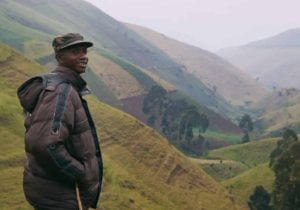 ▶ “This Is Congo,” to be screened at Theatre Three on April 9, is a riveting, unfiltered immersion into the world’s longest continuing conflict and those who are surviving within it. Following four compelling characters: a whistleblower, a patriotic military commander, a mineral dealer and a displaced tailor — the film offers viewers a truly Congolese perspective on the problems that plague this lushly beautiful nation. Moderated by Shimelis Gulema, professor of Africana studies and history, SBU, the guest speaker for the evening will be Director Daniel McCabe.
▶ “This Is Congo,” to be screened at Theatre Three on April 9, is a riveting, unfiltered immersion into the world’s longest continuing conflict and those who are surviving within it. Following four compelling characters: a whistleblower, a patriotic military commander, a mineral dealer and a displaced tailor — the film offers viewers a truly Congolese perspective on the problems that plague this lushly beautiful nation. Moderated by Shimelis Gulema, professor of Africana studies and history, SBU, the guest speaker for the evening will be Director Daniel McCabe.
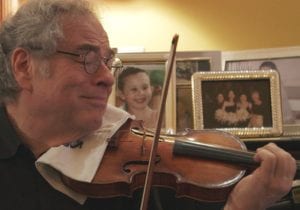 ▶ The series continues on April 16 at Theatre Three with an impressionist, fly-on-the-wall portrait of the life and glorious music of Israeli-born Itzhak Perlman, widely considered the greatest living violinist. Titled “Itzhak,” the documentary follows the virtuoso around the world for a year, portraying his huge passion and spirit. Wheelchair-bound from childhood polio, Perlman recounts overcoming obstacles with humor and talent. Featuring archival materials and performance clips, the guest speaker will be Director Alison Chernick.
▶ The series continues on April 16 at Theatre Three with an impressionist, fly-on-the-wall portrait of the life and glorious music of Israeli-born Itzhak Perlman, widely considered the greatest living violinist. Titled “Itzhak,” the documentary follows the virtuoso around the world for a year, portraying his huge passion and spirit. Wheelchair-bound from childhood polio, Perlman recounts overcoming obstacles with humor and talent. Featuring archival materials and performance clips, the guest speaker will be Director Alison Chernick.
 ▶ “Love, Cecil,” which will be screened at the Long Island Museum on April 23, brings to life the glamorous world of fashion/celebrity photographer and stage set designer, Cecil Beaton (1904-1980) through the use of archival footage, interviews and readings from his diaries by actor Rupert Everett. Guest speaker for the evening will be Director Lisa Immordino Vreeland.
▶ “Love, Cecil,” which will be screened at the Long Island Museum on April 23, brings to life the glamorous world of fashion/celebrity photographer and stage set designer, Cecil Beaton (1904-1980) through the use of archival footage, interviews and readings from his diaries by actor Rupert Everett. Guest speaker for the evening will be Director Lisa Immordino Vreeland.
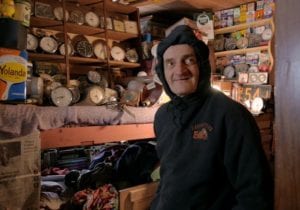 ▶ The final film for the spring 2018 season, “Mole Man” will be screened at the Long Island Museum on April 30 and follows Ron Heist, a 66-year-old autistic man who built a 50-room structure, consisting solely of scrap materials, on the land behind his parent’s home in Western Pennsylvania. His creation was built without the use of nails or mortar and keeps expanding, as he collects, classifies and displays objects from a deserted cluster of homes in the woods. This is the story of an extraordinary life, a family and the beauty of thinking differently. Director Guy Fiorita will be the guest speaker.
▶ The final film for the spring 2018 season, “Mole Man” will be screened at the Long Island Museum on April 30 and follows Ron Heist, a 66-year-old autistic man who built a 50-room structure, consisting solely of scrap materials, on the land behind his parent’s home in Western Pennsylvania. His creation was built without the use of nails or mortar and keeps expanding, as he collects, classifies and displays objects from a deserted cluster of homes in the woods. This is the story of an extraordinary life, a family and the beauty of thinking differently. Director Guy Fiorita will be the guest speaker.
All photos courtesy of the PJDS

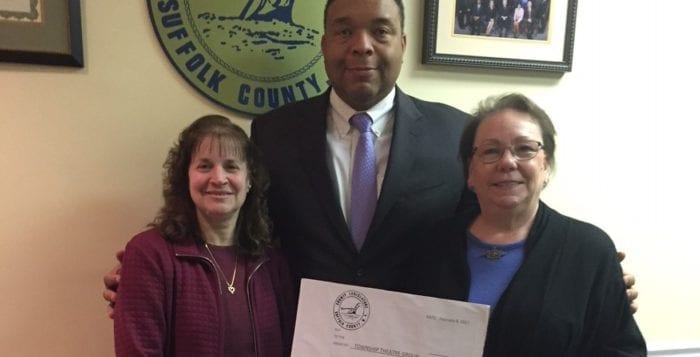


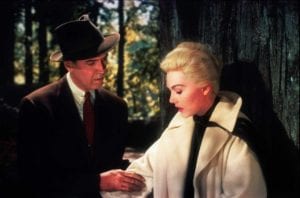 In celebration of the 60th anniversary of Alfred Hitchcock’s “Vertigo,” Fathom Events, Turner Classic Movies and Universal Pictures will bring the classic film to select cinemas nationwide on Sunday, March 18, and Wednesday, March 21.
In celebration of the 60th anniversary of Alfred Hitchcock’s “Vertigo,” Fathom Events, Turner Classic Movies and Universal Pictures will bring the classic film to select cinemas nationwide on Sunday, March 18, and Wednesday, March 21.

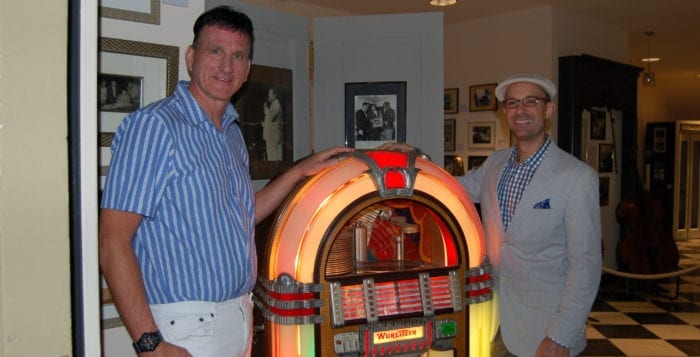



 ▶ The spring season will kick off with a special screening of “The China Hustle” at Theatre Three on March 19. The documentary exposes a new financial crime perpetrated by Wall Street where investors dumped their money into Chinese businesses that turned out to be fraudulent. The hook of the story is that everyone involved is guilty, including the investor who called out the fraud in the first place. Guest speakers will be Director Jed Rothstein by Skype and Juan Carlos Conesa, chair of Dept. of Economics, Stony Brook University.
▶ The spring season will kick off with a special screening of “The China Hustle” at Theatre Three on March 19. The documentary exposes a new financial crime perpetrated by Wall Street where investors dumped their money into Chinese businesses that turned out to be fraudulent. The hook of the story is that everyone involved is guilty, including the investor who called out the fraud in the first place. Guest speakers will be Director Jed Rothstein by Skype and Juan Carlos Conesa, chair of Dept. of Economics, Stony Brook University. ▶ “Sammy Davis, Jr: I’ve Gotta Be Me,” to be screened at the Long Island Museum on March 26, is the first major documentary to examine Davis’ vast talent and his journey for identity through the shifting tides of civil rights and racial progress in 20th century America. With interviews from Billy Crystal, Norman Lear, Jerry Lewis, Whoopi Goldberg and Kim Novak along with photographs, television, film and concert. Moderated by Tom Needham, host of “Sounds of Film” on WUSB, guest speaker will be screenwriter and co-producer Laurence Maslon.
▶ “Sammy Davis, Jr: I’ve Gotta Be Me,” to be screened at the Long Island Museum on March 26, is the first major documentary to examine Davis’ vast talent and his journey for identity through the shifting tides of civil rights and racial progress in 20th century America. With interviews from Billy Crystal, Norman Lear, Jerry Lewis, Whoopi Goldberg and Kim Novak along with photographs, television, film and concert. Moderated by Tom Needham, host of “Sounds of Film” on WUSB, guest speaker will be screenwriter and co-producer Laurence Maslon.
 ▶ “This Is Congo,” to be screened at Theatre Three on April 9, is a riveting, unfiltered immersion into the world’s longest continuing conflict and those who are surviving within it. Following four compelling characters: a whistleblower, a patriotic military commander, a mineral dealer and a displaced tailor — the film offers viewers a truly Congolese perspective on the problems that plague this lushly beautiful nation. Moderated by Shimelis Gulema, professor of Africana studies and history, SBU, the guest speaker for the evening will be Director Daniel McCabe.
▶ “This Is Congo,” to be screened at Theatre Three on April 9, is a riveting, unfiltered immersion into the world’s longest continuing conflict and those who are surviving within it. Following four compelling characters: a whistleblower, a patriotic military commander, a mineral dealer and a displaced tailor — the film offers viewers a truly Congolese perspective on the problems that plague this lushly beautiful nation. Moderated by Shimelis Gulema, professor of Africana studies and history, SBU, the guest speaker for the evening will be Director Daniel McCabe. ▶ The series continues on April 16 at Theatre Three with an impressionist, fly-on-the-wall portrait of the life and glorious music of Israeli-born Itzhak Perlman, widely considered the greatest living violinist. Titled “Itzhak,” the documentary follows the virtuoso around the world for a year, portraying his huge passion and spirit. Wheelchair-bound from childhood polio, Perlman recounts overcoming obstacles with humor and talent. Featuring archival materials and performance clips, the guest speaker will be Director Alison Chernick.
▶ The series continues on April 16 at Theatre Three with an impressionist, fly-on-the-wall portrait of the life and glorious music of Israeli-born Itzhak Perlman, widely considered the greatest living violinist. Titled “Itzhak,” the documentary follows the virtuoso around the world for a year, portraying his huge passion and spirit. Wheelchair-bound from childhood polio, Perlman recounts overcoming obstacles with humor and talent. Featuring archival materials and performance clips, the guest speaker will be Director Alison Chernick. ▶ “Love, Cecil,” which will be screened at the Long Island Museum on April 23, brings to life the glamorous world of fashion/celebrity photographer and stage set designer, Cecil Beaton (1904-1980) through the use of archival footage, interviews and readings from his diaries by actor Rupert Everett. Guest speaker for the evening will be Director Lisa Immordino Vreeland.
▶ “Love, Cecil,” which will be screened at the Long Island Museum on April 23, brings to life the glamorous world of fashion/celebrity photographer and stage set designer, Cecil Beaton (1904-1980) through the use of archival footage, interviews and readings from his diaries by actor Rupert Everett. Guest speaker for the evening will be Director Lisa Immordino Vreeland. ▶ The final film for the spring 2018 season, “Mole Man” will be screened at the Long Island Museum on April 30 and follows Ron Heist, a 66-year-old autistic man who built a 50-room structure, consisting solely of scrap materials, on the land behind his parent’s home in Western Pennsylvania. His creation was built without the use of nails or mortar and keeps expanding, as he collects, classifies and displays objects from a deserted cluster of homes in the woods. This is the story of an extraordinary life, a family and the beauty of thinking differently. Director Guy Fiorita will be the guest speaker.
▶ The final film for the spring 2018 season, “Mole Man” will be screened at the Long Island Museum on April 30 and follows Ron Heist, a 66-year-old autistic man who built a 50-room structure, consisting solely of scrap materials, on the land behind his parent’s home in Western Pennsylvania. His creation was built without the use of nails or mortar and keeps expanding, as he collects, classifies and displays objects from a deserted cluster of homes in the woods. This is the story of an extraordinary life, a family and the beauty of thinking differently. Director Guy Fiorita will be the guest speaker.
 I was truly blessed to live 12 wonderful years with great memories and milestones in Strong’s Neck. I wrote this non-fiction piece as a heartfelt thank you to a place that has so much enriched history and beautiful landscapes that, combined with my loving parents and sister, was “home.” Our new ventures take us to Queens and Manhattan. Thank you for reading.
I was truly blessed to live 12 wonderful years with great memories and milestones in Strong’s Neck. I wrote this non-fiction piece as a heartfelt thank you to a place that has so much enriched history and beautiful landscapes that, combined with my loving parents and sister, was “home.” Our new ventures take us to Queens and Manhattan. Thank you for reading. 

 Presented by the Suffolk County One-Stop Employment Center, representatives from the following companies are scheduled to attend: AFLAC, Attentive Care, Bachrach Group, Better Business Bureau, Bob’s Discount Furniture, Brightstar Care, Burlington Stores, Canon USA, Castella Imports, Catholic Guardian, Combined Insurance, First In Service Staffing, Flexstaff, Helen Keller Services for the Blind, Home Depot, Interim Healthcare, LIRR, Lloyd Staffing, Northwell Health, NRL Strategies, Options for Community Living, People Ready, Prudential, Renewal by Andersen, SCO Family of Services, SCOPE, SCWA, South Shore Home Health, Suffolk County Civil Service and Well Life Network.
Presented by the Suffolk County One-Stop Employment Center, representatives from the following companies are scheduled to attend: AFLAC, Attentive Care, Bachrach Group, Better Business Bureau, Bob’s Discount Furniture, Brightstar Care, Burlington Stores, Canon USA, Castella Imports, Catholic Guardian, Combined Insurance, First In Service Staffing, Flexstaff, Helen Keller Services for the Blind, Home Depot, Interim Healthcare, LIRR, Lloyd Staffing, Northwell Health, NRL Strategies, Options for Community Living, People Ready, Prudential, Renewal by Andersen, SCO Family of Services, SCOPE, SCWA, South Shore Home Health, Suffolk County Civil Service and Well Life Network.


